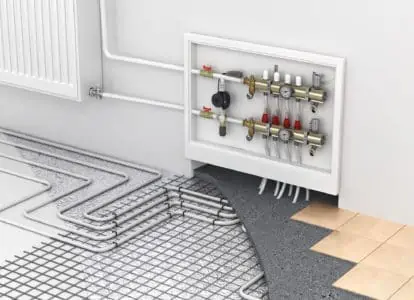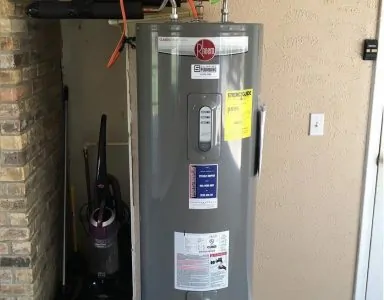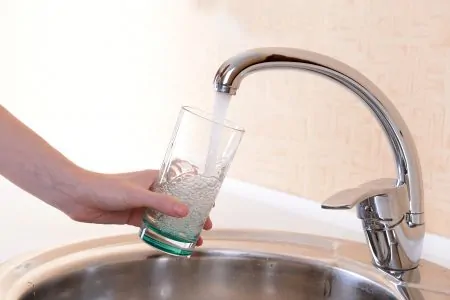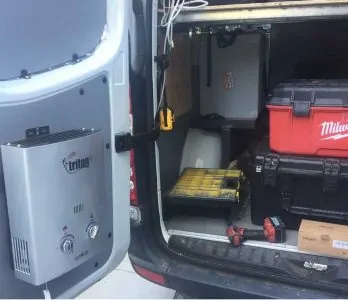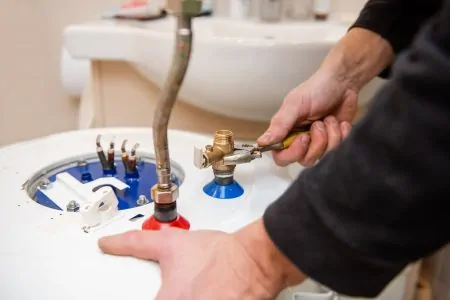Are you thinking of getting an efficient heating solution that makes the entire house feel warm without spending a fortune on bills?
Then hydronic radiant floor heating might be the best option. Concealed in the floor and efficiently reheating water, in-floor radiant heat could be a convenient solution for many homeowners.
Key Takeaways
- Hydronic radiant floor heating uses water-filled tubes under the floor to provide efficient, uniform heat in a room.
- These systems are more energy-efficient than forced-air heating and work with various flooring types, such as tile, wood, and laminate.
- Installation costs for hydronic systems can be high, but they offer long-term savings on energy bills.
- When considering radiant floor heating, it’s essential to factor in the type of flooring, installation spots, and overall project costs.
- How Does Radiant Floor Heating Work?
- How Do Hydronic Radiant Floor Heating Systems Work?
- Hydronic vs. Forced-Air Heating
- Hydronic vs. Electric Radiant Floor Heating
- Advantages and Disadvantages of Radiant Floor Heating
- Cost of Hydronic Radiant Floor Heating
- Can I Install Radiant Floor Heating Myself?
- What To Consider When Installing a Heating System
- Best Hydronic Radiant Floor Heating Systems
- FAQs
- Bottom Line
How Does Radiant Floor Heating Work?
Radiant flooring uses thermal radiation to heat your floors. It’s a clever way to heat your home because the flooring becomes hot, and that heat then rises and warms the space. You can have them professionally installed or buy heating kits to install yourself.
Picture a snake-shaped piping system that goes through your floor and is attached to a manifold at both ends. PEX tubes are pretty flexible, and hydronic radiant floor heating systems take advantage of this flexibility.
Since the floor is sealed, the tubing doesn’t have any joints, with each loop being nine inches apart from the others. You can cover this tube system using dry-tamped mortar, gypcrete, or concrete. These materials can hold and radiate heat throughout the room even when the heat is not turned on.
How Do Hydronic Radiant Floor Heating Systems Work?
Thanks to the manifold, the water is distributed evenly across the length of the PEX tubes.
Since the other end of the system is connected to a water heater, this helps water circulate through the tubes and reruns it afterward to reheat it.
Hydronic vs. Forced-Air Heating
Hydronic radiant floor heating has recently gained more popularity, dethroning forced-air heating due to its higher efficiency.
How it Works
Hydronic systems use flexible tubing connected to a boiler or a water heater, and they recirculate heated water throughout the floor.
Forced-air heating uses a furnace and a ductwork system that needs to run throughout the entire house. The latter option is not as efficient as a hydronic system because it’s more prone to cold spots and requires regular cleaning to prevent airborne allergens.
When to Use it
You want to install a hydronic system if you’re building or renovating a house and haven’t installed the flooring yet. They’re even a great option for people who love uniform heating and are ready for a higher upfront cost but higher savings in the long run.
Forced-air heating systems are more efficient from a cost standpoint if you already have existing ductwork.
Cost
Hydronic systems usually start at around $6 per square foot. But they are pretty expensive to install, considering how much labor costs are. You can expect to pay at least $900 for a 150 square foot room.
Expect to pay around $800 for a forced-air unit, plus another $500 for installation costs. However, you also need to consider cost variations based on location, ductwork, or gas piping required.
Hydronic vs. Electric Radiant Floor Heating
Radiant floor heating is available in one of two types: electric and hydronic. Let’s take a side-by-side look at the two to see which one is most suited for you.
How it Works
Hydronic systems are made with a loop of flexible tubing hidden underneath the floor. The tubes are connected to a boiler, heating water that flows through the tubes.
Visualize a mesh that has loops of electric cables on it. That’s what electric radiant floor heating looks like. These cables generate heat using electricity and don’t require water or boilers.
When to Use it
Hydronic systems are ideal for heating the whole house. In the long run, they are cost-effective, but they cost more to install because of all the labor and materials involved.
On the other hand, electric systems are very easy to install, but the costs to run them are pretty high. They are best suited for spot heating, such as on the bathroom or kitchen floor.
Cost
The cost to install a hydronic radiant floor heating system is about $6 to $15 per square foot. The average to install an electric system is around $11 per square foot.
Advantages and Disadvantages of Radiant Floor Heating
Naturally, there are advantages and drawbacks to choosing in-floor radiant heat:
Pros
- Ability to provide uniform heating across the entire room.
- Operates quietly.
- No visible pipes to impede the beautiful design of the room.
- Compatible with a lot of different floor coverings.
Cons
- Depends on boilers to function, increasing project cost.
- Installation costs can be pretty high, especially if you choose a hydronic heating system.
- Can take a long time to install.
Cost of Hydronic Radiant Floor Heating
Like anything, the cost is subjective and depends on several factors.
Installation Cost
Hydronic systems don’t cost very much to install, starting at $6 per square foot. But it is preferable to install one of these systems during a renovation or new construction to prevent having to rip up an old flooring system. The cost of removing an existing floor will vary substantially based on the material used and the size of the room.
In some circumstances, you will also need to provide additional support for the sub-floor to bear the filler material’s increased weight.
Something else you have to factor in when thinking about installation costs are temperature zones. Because you spend more time in certain rooms than in others, said rooms have a higher average temperature.
Labor costs depend on the area you live, but they typically range between $8 to $12 per square foot. Installing a hydronic radiant floor heating system can range anywhere from $6,000 to $14,000.
Operation Cost
Thanks to the invention of the thermostat, it can be cheaper to run a hydronic system than an HVAC system.
Consider that the floor radiates heat even when the heat is turned off. And, since water is more efficient in terms of heat retention, the system doesn’t need that much energy to reheat the water in the tubes. This could result in energy savings of up to 30 percent.
Generally speaking, running a hydronic radiant floor heating system costs between $1 to $5 per day. That means you can expect to pay between $30 to $150 per month.
Can I Install Radiant Floor Heating Myself?
Since labor costs can be pretty high, many people wonder how they can install radiant floor heating as a DIY project. You need to be comfortable with setting the floor tiles but, if you are, you can install the system by yourself.
Take Note
It is still recommended that you call a licensed electrician to hook up the electrical circuit.
What To Consider When Installing a Heating System
If you like the idea of hydronic floor heating, there are still a few things to consider.
Flooring Type
As a general rule, stone and ceramic tiles are the best heat conductors. However, hydronic floor heating works with almost any type of flooring out there, including wooden, laminate, or engineered floorboards.
Installation Spots
Hydronic floor heating systems work in just about any room in the house.
Due to their higher installation costs but money-saving in the long run, they are recommended where you spend most of your time. Spaces like bedrooms, living rooms, or home offices are best. For the bathroom, you can also consider electric floor heating systems.
Cost Factors
We already discussed the costs per square foot, but you also need to consider the many factors that influence the end cost.
If you’re just building your floors, you can install the system before installing the floors. That makes it cheaper than removing existing floors and adding them again.
Best Hydronic Radiant Floor Heating Systems
If you are intrigued and are considering installing a radiant floor heating system, you’re probably wondering which brand to turn to.
InFloor
InFloor is a company that sells both outdoor and indoor radiant heating products. Hydronic and electric floor heating systems are part of those products, and they work with any floor covering.
Janes Radiant
If you want solid hydronic and electric heating systems, Janes Radiant is another brand you should look into. Their products are compatible with stone, tiles, wood, carpet, and vinyl.
SunTouch
In addition to electric underfloor heating systems for indoor usage, SunTouch also offers systems for outdoor use. The underflooring systems can be used with wooden joists or concrete slabs. Plus, they are suitable with various flooring materials such as wood, stone, and tile.
FAQs
Bottom Line
Hydronic radiant floor heating is a great way to heat the house if you can fork up the money upfront. These systems are very efficient in the long run, and the pipes are concealed underneath the floor, so they will never get in the way visually.
